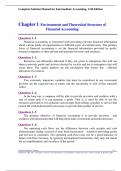Exam (elaborations)
TEST BANK FOR INTERMEDIATE ACCOUNTING, 11TH EDITION BY DAVID SPICELAND, MARK NELSON, THOMAS WAYNE, JENNIFER COMPLETE ALL CHAPTERS
- Course
- Institution
TEST BANK FOR INTERMEDIATE ACCOUNTING, 11TH EDITION BY DAVID SPICELAND, MARK NELSON, THOMAS WAYNE, JENNIFER COMPLETE ALL CHAPTERS
[Show more]



